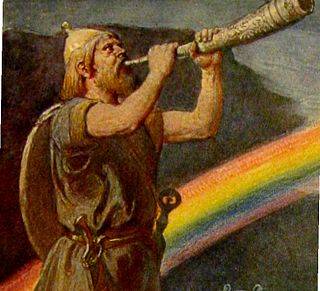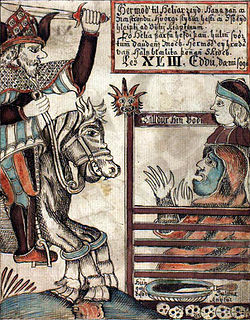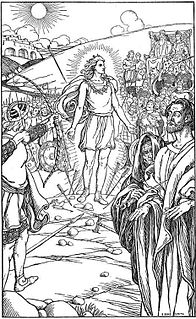
In Norse religion, Asgard is one of the Nine Worlds and home to the Æsir tribe of gods. It is surrounded by an incomplete wall attributed to a Hrimthurs riding the stallion Svaðilfari, according to Gylfaginning. Odin and his wife, Frigg, are the rulers of Asgard.

In Norse mythology, Bifröst is a burning rainbow bridge that reaches between Midgard (Earth) and Asgard, the realm of the gods. The bridge is attested as Bilröst in the Poetic Edda; compiled in the 13th century from earlier traditional sources, and as Bifröst in the Prose Edda; written in the 13th century by Snorri Sturluson, and in the poetry of skalds. Both the Poetic Edda and the Prose Edda alternately refer to the bridge as Ásbrú.
In Norse mythology, Hvergelmir is a major spring. Hvergelmir is attested in the Poetic Edda, compiled in the 13th century from earlier traditional sources, and the Prose Edda, written in the 13th century by Snorri Sturluson. In the Poetic Edda, Hvergelmir is mentioned in a single stanza, which details that it is the location where liquid from the antlers of the stag Eikþyrnir flow, and that the spring, "whence all waters rise", is the source of numerous rivers. The Prose Edda repeats this information and adds that the spring is located in Niflheim, that it is one of the three major springs at the primary roots of the cosmic tree Yggdrasil, and that within the spring are a vast amount of snakes and the dragon Níðhöggr.
In Norse mythology, Muspelheim, also called Muspell, is a realm of fire.
Niflheim or Niflheimr is one of the Nine Worlds and is a location in Norse mythology which sometimes overlaps with the notions of Niflhel and Hel. The name Niflheimr only appears in two extant sources: Gylfaginning and the much-debated Hrafnagaldr Óðins.

In Norse mythology, Sleipnir is an eight-legged horse ridden by Odin. Sleipnir is attested in the Poetic Edda, compiled in the 13th century from earlier traditional sources, and the Prose Edda, written in the 13th century by Snorri Sturluson. In both sources, Sleipnir is Odin's steed, is the child of Loki and Svaðilfari, is described as the best of all horses, and is sometimes ridden to the location of Hel. The Prose Edda contains extended information regarding the circumstances of Sleipnir's birth, and details that he is grey in color.

In Norse mythology, Hel, the location, shares a name with Hel, a being who rules over the location. In late Icelandic sources, varying descriptions of Hel are given and various figures are described as being buried with items that will facilitate their journey to Hel after their death. In the Poetic Edda, Brynhildr's trip to Hel after her death is described and Odin, while alive, also visits Hel upon his horse Sleipnir. In Snorri Sturluson's Prose Edda, Baldr goes to Hel on his death and subsequently Hermóðr uses Sleipnir to attempt to retrieve him.
The numbers three and nine are significant numbers in Norse mythology and paganism. Both numbers appear throughout surviving attestations of Norse paganism, in both mythology and cultic practice.

Hermóðr the Brave is a figure in Norse mythology, a son of the god Odin. He is often considered the messenger of the gods.
In Norse mythology, Alvaldi or Ölvaldi was a giant and the father of Þjazi, Gangr and Iði as well as the grandfather of Skaði. According to Skáldskaparmál, Ölvaldi was very rich in gold, and when he died his three sons divided his inheritance among themselves, measuring it out by each in turn taking a mouthful. For this reason the expressions "speech of Þjazi, Gangr or Iði" and "Iði's shining talk" are kennings for gold.
In Norse mythology, Élivágar are rivers that existed in Ginnungagap at the beginning of the world. The Prose Edda relates:
In Norse mythology, Gnipahellir is a mythical cave. Gnipahellir is the home of Garmr, the hellhound who guards the gates of Hel, the Norse realm of the dead. Garmr is often featured chained here until the onset of Ragnarök, at which time his bindings break and he runs free. Reference to Gnipahellir appears in Vǫluspá, Prophecy of the Völva, one of the poems of the Poetic Edda.

In Norse mythology, Himinbjörg is the home of the god Heimdallr. Himinbjörg is attested in the Poetic Edda, compiled from earlier traditional sources, and the Prose Edda and Heimskringla, both written in the 13th century by Snorri Sturluson. Himinbjörg is associated with Heimdallr in all sources. According to the Poetic Edda, Heimdallr dwells there as watchman for the gods and there drinks fine mead, whereas in the Prose Edda Himinbjörg is detailed as located where the burning rainbow bridge Bifröst meets heaven. Scholars have commented on the differences between the two attestations and linked the name of the mythical location to various place names.

In Norse mythology, Eggthér is a giant and herdsman who is described as sitting on a mound and joyfully playing his harp while the red rooster Fjalar begins to crow, heralding the onset of Ragnarök.
Hermod is a fictional character appearing in American comic books published by Marvel Comics. The character is based on the Hermóðr of Norse myth.
In Norse mythology, Móðguðr refers to the female guardian of the bridge over the river Gjöll ("Noisy"), Gjallarbrú. She allowed the newly dead to use the bridge to cross from one side of the river Gjöll to the other if the soul stated his or her name and business, and possibly in turn prevented the dead beyond the river from crossing back over Gjöll into the lands of the living.
In Norse mythology, Iði was a giant and a son of Alvaldi along with his brothers Þjazi and Gangr. According to Skáldskaparmál, Alvaldi was very rich in gold, and when he died his three sons divided his inheritance among themselves, measuring it out by each in turn taking a mouthful. For this reason the expressions "speech of Þjazi, Gangr or Iði" and "Iði's shining talk" are kennings for gold.
In Norse mythology, Gangr or Gang was a giant and a son of Ölvaldi, along with his brothers Þjazi and Iði. According to Skáldskaparmál, Ölvaldi was very rich in gold, and when he died his three sons divided his inheritance among themselves, measuring it out by each in turn taking a mouthful. For this reason the expressions "speech of Þjazi, Gangr or Iði" and "Iði's shining talk" are kennings for gold.

In Norse mythology, the Kerlaugar i.e. "bath-tub", are two rivers through which the god Thor wades. The Kerlaugar are attested in the Poetic Edda, compiled in the 13th century from earlier traditional material, and in a citation of the same verse in the Prose Edda, written in the 13th century by Snorri Sturluson.












